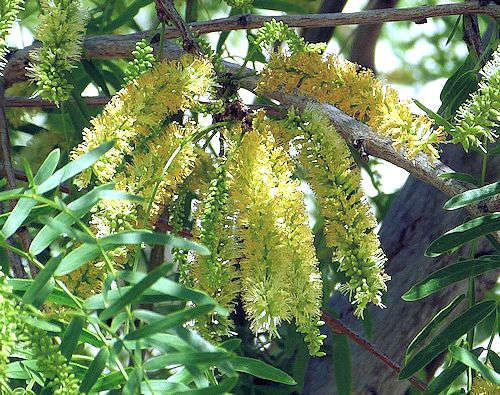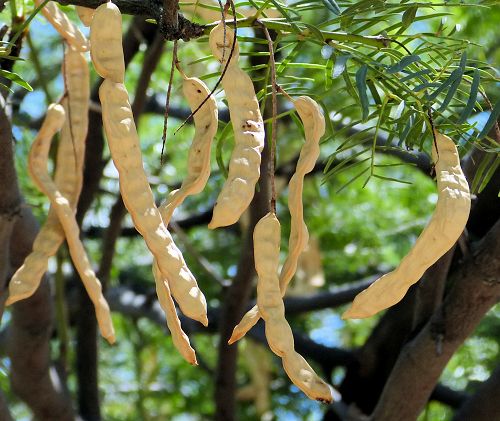Growing Neltuma glandulosa:
Honey Mesquite
Back to Trees and Palms
Description
Form: Tree.
Leaf retention: Deciduous.
Growth rate: Moderate to rapid, depending on water.
Mature Size: 10-30' (3-9m) high and as wide.
Flowers: Yellow, bottle brush shaped, fragrant.
Bloom: Spring or summer.
Fruit: A seed pod, light tan, flattened or cylindrical, straight to slightly curved on tree, constricted around the seeds. The pods and seeds are edible and usually ground into flour.
Leaves: Bright green, compound leaflets, linear, up to 2" (5cm) long. This tree provides medium to dense shade.
Stems: Spines up to 2" (5cm) long in the wild. Nurseries often sell thornless cultivars.
Roots: Nitrogen-fixing*, large deep taproot, aggressive.
Wildlife: The flowers attract bees and butterflies. The seedpods, high in sugar, attract birds and mammals, including cattle. This tree is a larval host to some species of butterflies.
Toxic / Danger: Sharp spines on some specimens.
Origin: Mexico, southwestern United States, Missouri and Louisiana.
Form: Tree.
Leaf retention: Deciduous.
Growth rate: Moderate to rapid, depending on water.
Mature Size: 10-30' (3-9m) high and as wide.
Flowers: Yellow, bottle brush shaped, fragrant.
Bloom: Spring or summer.
Fruit: A seed pod, light tan, flattened or cylindrical, straight to slightly curved on tree, constricted around the seeds. The pods and seeds are edible and usually ground into flour.
Leaves: Bright green, compound leaflets, linear, up to 2" (5cm) long. This tree provides medium to dense shade.
Stems: Spines up to 2" (5cm) long in the wild. Nurseries often sell thornless cultivars.
Roots: Nitrogen-fixing*, large deep taproot, aggressive.
Wildlife: The flowers attract bees and butterflies. The seedpods, high in sugar, attract birds and mammals, including cattle. This tree is a larval host to some species of butterflies.
Toxic / Danger: Sharp spines on some specimens.
Origin: Mexico, southwestern United States, Missouri and Louisiana.
Cultivation and Uses
USDA hardiness zones: 6-10.
Heat tolerant: Yes.
Drought tolerant: Yes.
Sun: Full sun.
Soil: Well draining, dry, low in organic content, pH 6.6-8.5 (neutral to alkaline). *Do not use a nitrogen fertilizer.
Water after becoming established: Water deeply, every two months during drought. Always water past the drip line of the tree and away from the trunk to encourage lateral root development. Water encourages crown growth and mesquites without sufficiently wide roots can be blown over by strong winds. Do not water more often because this will result in weak wood.
Prune: Wait two years after planting before pruning honey mesquite trees to give them time to become established. Prune in the summer months. Thin the canopy by removing branches that rub against or cross each other inside the bulk of the tree. Cut branches that are growing in conflicting directions. Remove dead, damaged or diseased limbs. Raise the canopy by trimming off the lower branches, especially those that are growing in a downward direction. Remove any shoots growing from the roots, along with weeds.
Litter: Seedpods.
Propagation: Scarified seed.
Uses: Ornamental, low water (xeriscape) garden, edible seedpods.
USDA hardiness zones: 6-10.
Heat tolerant: Yes.
Drought tolerant: Yes.
Sun: Full sun.
Soil: Well draining, dry, low in organic content, pH 6.6-8.5 (neutral to alkaline). *Do not use a nitrogen fertilizer.
Water after becoming established: Water deeply, every two months during drought. Always water past the drip line of the tree and away from the trunk to encourage lateral root development. Water encourages crown growth and mesquites without sufficiently wide roots can be blown over by strong winds. Do not water more often because this will result in weak wood.
Prune: Wait two years after planting before pruning honey mesquite trees to give them time to become established. Prune in the summer months. Thin the canopy by removing branches that rub against or cross each other inside the bulk of the tree. Cut branches that are growing in conflicting directions. Remove dead, damaged or diseased limbs. Raise the canopy by trimming off the lower branches, especially those that are growing in a downward direction. Remove any shoots growing from the roots, along with weeds.
Litter: Seedpods.
Propagation: Scarified seed.
Uses: Ornamental, low water (xeriscape) garden, edible seedpods.
Comments
This plant is a member of the Legume family (Fabaceae). Its scientific synonym is Prosopis glandulosa. 'Maverick' is a well known thornless cultivar.
Do you have additional information or a different experience for these plants that you would like to share? Email info@GardenOracle.com. All contributions are welcome and appreciated.
This plant is a member of the Legume family (Fabaceae). Its scientific synonym is Prosopis glandulosa. 'Maverick' is a well known thornless cultivar.
Do you have additional information or a different experience for these plants that you would like to share? Email info@GardenOracle.com. All contributions are welcome and appreciated.


Latest update: July, 2024
© 2008-2025 by GardenOracle.com

